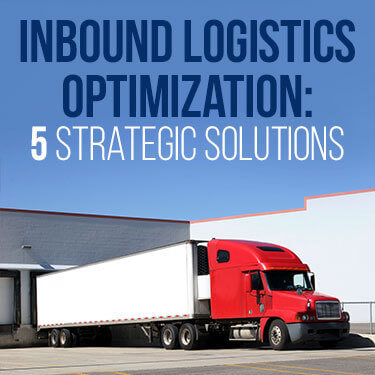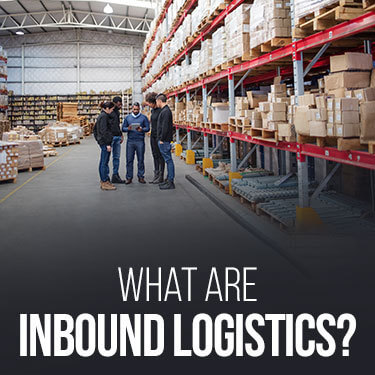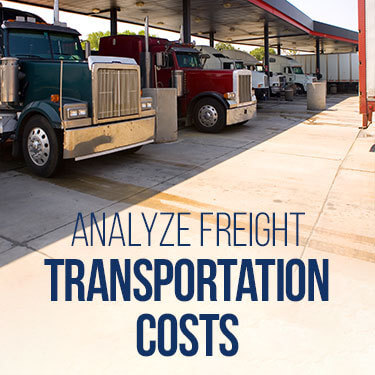
 Copy URL to Clipboard
Copy URL to Clipboard
Inbound logistics optimization isn’t just for businesses that need a boost - every business can benefit. Optimization, whether of inbound or outbound solutions, is about keeping up with change and making sure your company is using innovative strategies. In business, especially the freight business - movement is money.
Optimizing inbound logistics is possible by implementing five business solutions for short- and long-term benefits.
The application of these strategies helps maintain supply chain success.
Learn more about these solutions and how to put them into practice in your business.
Table of Contents
Without inbound logistics, there are no outbound logistics to service customers. In terms of the supply chain, inbound logistics are the first links that connect businesses with suppliers.
Optimizing your inbound logistics means that you are strengthening the foundation of your business. If you can’t get supplies to your production and manufacturing centers, there is no final product to sell to a customer. When it comes to supply chain management, how you start may have a large impact on how it ends.

In simple terms, inbound logistics describes the process of getting raw materials or goods from a supplier to a business. The products themselves may change depending on what kind of business you have, but the intent remains the same.
Consider the kind of materials a food processing plant that makes and packages cornmeal might need. Actual corn needs to be shipped in, paper or plastic containers need to be set up, and labor needs to be organized. All these things make up inbound logistics.
Perhaps your company doesn’t do any kind of manufacturing, like an eCommerce store that sells athletic wear. Inbound logistics are still needed to ensure you have inventory available when a dozen people decide they need the new sneakers you just posted on your site.

If your business produces anything, from cupcakes to cupholders, any interruptions in your inbound logistics can bring things to a stop.
Forgot to renew your deal with the flour supplier? No cupcakes today unless you spend more money to get things delivered last minute. Now you’re potentially impacting your bottom line and slowing down production.
On the flip side of things, an optimized inbound system can help your business earn more and spend less. Inbound logistics optimization is going to be a factor in determining the speed, or lead time, at which your finished goods are made and distributed.
Let's consider the example of a cupcake shop. Among the basic staples are flour, eggs, butter, and milk. If you order too little, getting more shipped in on short notice would be expensive and time-consuming. If you order too much, you risk the supplies going bad because you weren’t able to use them in time.
Optimizing your inbound logistics can allow you to adjust shipping processes so that your materials arrive in just the right quantities to match your output. You get to reduce costs and increase profits. Customer experience in your cupcake shop increases because lead times are consistent and cupcakes are readily available.
Want to know more? Check out our article on procurement vs logistics.
Of course, setting up the perfect delivery schedule is just one way that inbound logistics impact business. If you really want to learn how to optimize inbound logistics for multiple parts of your business, there are a number of different strategies available.
Check out five methods you can start putting into practice now so you can reap the benefits later.
In a world that is increasingly digital, building personal relationships with suppliers can be difficult. If your supplies are coming from overseas, you may be faced with language barriers as well.
Not every supplier will be loyal and there may be times when you have no choice but to switch. Even so, taking the time to communicate one on one and maintaining long-term contracts with them has proven benefits.
Developing a relationship with a supplier is worth the long-term benefits, especially for efficiency. A supplier you have a direct relationship with may be more inclined to let you know of a shortage or surplus of materials before a delivery is made.
Perhaps you run a mechanic shop and always use the same supplier for your oil filters. Your supplier may have industry insights into the likelihood of a shortage in the future and advise you to order slightly more one day. They would be able to do so because they are already familiar with your ordering habits.
Such actions can help you guarantee stock for your customers and balance your inventory to have specific needs on hand.
Speaking of inventory, having a set system in place to manage inventory can help you avoid unnecessary stockpiling of merchandise. While a good supplier can point out some trends, you are the one living the business day-to-day.
If you are experiencing frequent shortages or notice that a particular product keeps piling up, invest in a Warehouse Management System (WMS). Through product and activity tracking, a WMS can assist in many areas.
Such systems can track your production, inventory, and outgoing products. As with building supplier relationships, the goal is to optimize time and spending.
There are many different levels of warehouse and inventory management systems out there. If you are partnering with a Third Party Logistics (3PL) service, they are likely to have a WMS in place to manage receiving processes in real time.

Freight shipping and distribution are becoming some of the most expensive aspects of running a business. If you are expecting shipments from overseas, you may be waiting months for delivery and need to set up additional shipping services.
Having automated systems that track your inventory is going to help smooth out transportation costs. Whenever possible, you want to avoid spot rates. Contract freight services are consistently less expensive than spot rates when shipping.
| Month/Year | Dry Van Rates Per Mile | Flat Bed Rates Per Mile |
| June 2020 | $1.81 | $2.07 |
| January 2021 | $2.36 | $2.49 |
| June 2021 | $2.67 | $3.15 |
| January 2022 | $3.10 | $3.12 |
In the last two years, spot rates have gone up nearly 60%. Using such services frequently would then have a major impact on your shipping budget.
To find the most cost-effective transport methods, you may have to think along less traditional routes. If you previously used Full truckload shipping for all your needs, but don’t really use up the entire dry van, consider switching to an LTL truck service where you share van space with others.
Additional bulk orders may also be appropriate. If you have raw materials traveling from Shanghai to Los Angeles three times a year, perhaps consider consolidating so that everything arrives in one shipment. This could save you from having to arrange frequent transport at a time when port delays are at an all-time high.
The same can be done for domestic raw materials if possible. Working with your chosen carrier for route planning and other inbound logistics processes helps your budget.
Much like building supplier relationships, strong carrier relationships carry your business into the future with greater consistency and dependability. If you need to switch carriers, knowing your freight transport requirements will help with the development of routing guides to set expectations upfront.
Whether your business is just starting or simply expanding, taking the time to create official Vendor Inbound Compliance Standards can guide your selection of vendors and suppliers.
A VICS system can be used as a standard for selecting new vendors and suppliers, or it can be used to better define the terms you have with an existing vendor.
Standards can be enforced through a chargeback system, so long as terms are clearly outlined between you and your vendor from the beginning. VICS isn’t meant to be a punishment tool, but rather an outline to improve supplier relationships.
The foundation of most good relationships is a clear understanding of expectations on either side. Common points of a VICS include:
When making your VICS, be realistic in your expectations rather than flexible. A reasonable set of standards will go over much more easily with current and potential suppliers versus one that is too strict. If you are constantly needing to make exceptions, the documents will not have the same effect.
Plentiful and organized data is the best friend of supply chain and logistics management services. From tracking order frequency to maintenance of shipping cost records, data is necessary.
Data gathering won’t just help your inbound logistics either. With the right data, you can smooth out outbound logistics processes as well. Once you have your production and inventory well managed, the next step is to set up distribution center optimization.
Data points to gather specifically may include:
These and others may prove invaluable to future business plans. Data may indicate a need to scale certain operations up or down. If you use it to track employee activities, it might be used as a rewards tool to promote employees based on high performance.
Hopefully, you have taken the time to invest in the WMS. Such systems make the collection of data straightforward and can be set up with relative ease.
Growing your business takes hard work and dedication. Inbound logistics optimization can help you work smarter too and take some of that load off. R+L Global Logistics stands on hand to be your 3PL partner and guide you through the process.
Our team members live and breathe logistics and have access to technology designed to support business owners and their unique needs.
We offer reverse logistics services to handle returns and have a large network of carriers to get your supplies delivered from anywhere in the world.
Call us today at (866) 989 - 3082 to speak with a representative or request a services quote now. Optimize your inbound logistics now and reap the benefits for years to come.
